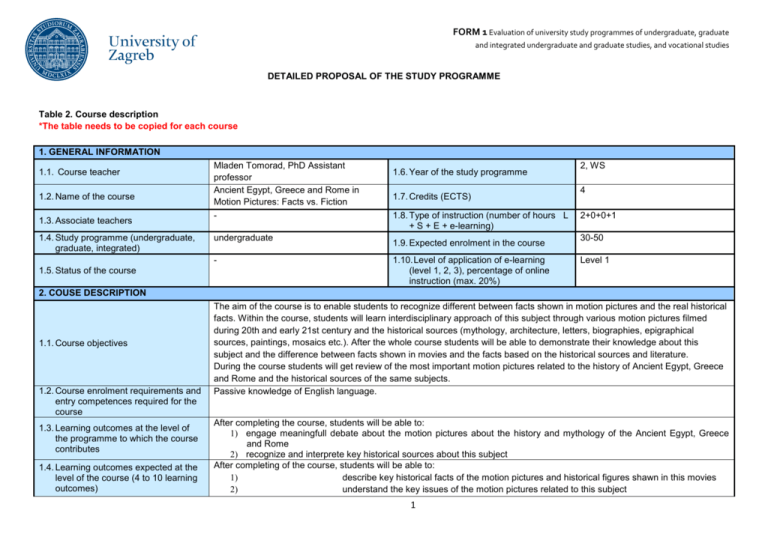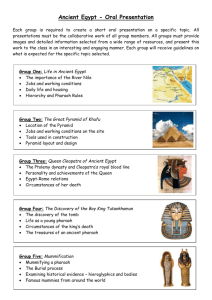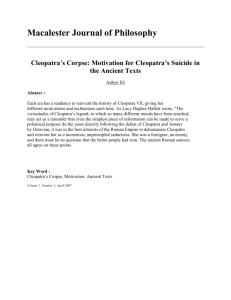Table 2 - Hrvatski studiji
advertisement

FORM 1 Evaluation of university study programmes of undergraduate, graduate and integrated undergraduate and graduate studies, and vocational studies DETAILED PROPOSAL OF THE STUDY PROGRAMME Table 2. Course description *The table needs to be copied for each course 1. GENERAL INFORMATION 1.1. Course teacher 1.2. Name of the course 1.3. Associate teachers 1.4. Study programme (undergraduate, graduate, integrated) Mladen Tomorad, PhD Assistant professor Ancient Egypt, Greece and Rome in Motion Pictures: Facts vs. Fiction undergraduate - 1.5. Status of the course 1.6. Year of the study programme 1.7. Credits (ECTS) 1.8. Type of instruction (number of hours L + S + E + e-learning) 1.9. Expected enrolment in the course 1.10. Level of application of e-learning (level 1, 2, 3), percentage of online instruction (max. 20%) 2, WS 4 2+0+0+1 30-50 Level 1 2. COUSE DESCRIPTION 1.1. Course objectives 1.2. Course enrolment requirements and entry competences required for the course 1.3. Learning outcomes at the level of the programme to which the course contributes 1.4. Learning outcomes expected at the level of the course (4 to 10 learning outcomes) The aim of the course is to enable students to recognize different between facts shown in motion pictures and the real historical facts. Within the course, students will learn interdisciplinary approach of this subject through various motion pictures filmed during 20th and early 21st century and the historical sources (mythology, architecture, letters, biographies, epigraphical sources, paintings, mosaics etc.). After the whole course students will be able to demonstrate their knowledge about this subject and the difference between facts shown in movies and the facts based on the historical sources and literature. During the course students will get review of the most important motion pictures related to the history of Ancient Egypt, Greece and Rome and the historical sources of the same subjects. Passive knowledge of English language. After completing the course, students will be able to: 1) engage meaningfull debate about the motion pictures about the history and mythology of the Ancient Egypt, Greece and Rome 2) recognize and interprete key historical sources about this subject After completing of the course, students will be able to: 1) describe key historical facts of the motion pictures and historical figures shawn in this movies 2) understand the key issues of the motion pictures related to this subject 1 FORM 1 Evaluation of university study programmes of undergraduate, graduate and integrated undergraduate and graduate studies, and vocational studies DETAILED PROPOSAL OF THE STUDY PROGRAMME understand the key issues of the history of Ancient Egypt, Greece and Rome understand the key issues of the various myths and legends of the heroes shown in the motion pictures related to this subject 5) understand the key issues and development of motion pictures related to the Ancient world 6) explain the meaning of the Ancient world 7) identify the major characteristics of the motion pictures related to the history of Ancient Egypt, Greece and Rome Major topics 3) 4) 1) Ancient Egypt in motion pictures: facts vs. fiction. Major themes: 1) Cleopatra: Antony and Cleopatra (1908), Cleopatra (1910), Cleopatra (1912), Marcantonio e Cleopatra (1913), Cleopatra (1934), Cleopatra (1943), Caesar and Cleopatra (1945), Anthony and Cleopatra (1951), Serpent of the Nile (1953), Due notti con Cleopatra (1953), Una regina per Cesare (1962), Cleopatra (1963), Antony and Cleopatra (1972); 2) Pyramid building: Land of the Pharaohs (1955); 3) Ancient Egyptian literature (Sinuhe the Egyptian): The Egyptian (1954); 4) Exodus: The Ten Commandments (1956). 1.5. Course content broken down in detail by weekly class schedule (syllabus) 2) Ancient Greece in motion pictures: facts vs. fiction. Major themes: 1) mythology: Jason and the Argonauts (1963), Troy (2004), Clash of the Titans (1981), Clash of the Titans (2010), Wrath of the Titans (2012), Immortals (2011) 2) Greaco-Persian wars: The 300 Spartans (1962), 300 (2006); 3) Alexander the Great: Alexander the Great (1956), Alexander (2004). 3) Ancient Rome in motion pictures: facts vs. fiction. Major themes: 1) Beginning of Christianity: Quo Vadis (1951); The Robe (1953), Ben Hur (1959); 2) Wars with barbarians: The fall of the Roman Empire (1964); Attila (1954); 3) gladiators: Spartacus (1960), Gladiator (2000); 4) Julius Caesar: Julius Caesar (1953), Julius Caesar (1970). x 1.6. Format of instruction: 1.8. Student responsibilities 1.9. Screening student work (name the lectures 1.7. Comments: independent assignments seminars and workshops x multimedia and the internet exercises laboratory on line in entirety work with mentor partial e-learning (other) field work Attend classes, prepare seminar essay, pass two colloquiums, participate in group disccusions. 1 1 Class attendance Research Practical training 2 FORM 1 Evaluation of university study programmes of undergraduate, graduate and integrated undergraduate and graduate studies, and vocational studies DETAILED PROPOSAL OF THE STUDY PROGRAMME proportion of ECTS credits for each activity so that the total number of ECTS credits is equal to the ECTS value of the course ) 2.10. Grading and evaluating student work in class and at the final exam Experimental work Essay Tests Written exam 2 2* Class attendance 25 % Colloquium 50 % or Written exam at the end of term (50 %): - 1st colloquium 25% - 2nd colloqium 25% - Written exam 50 % Seminar essay 25% Number of copies in the library Title 2.11. Required literature (available in the library and via other media) (other) (other) (other) (other) Report Seminar essay Oral exam Project Tomorad, M. (2013) Ancient Egypt, Greece and Rome in Motion Pictures: Facts vs. Fiction (PowerPoint Presentations). Zagreb: Hrvatski studiji Sveučilišta u Zagrebu. Tomorad, M. (2013) Staroegipatska civilizacija. Zagreb. Shaw, I. (ed., 2000) Oxford history of Ancient Egypt. Oxford. 2.12. Optional literature (at the time of submission of study programme proposal) Zamarovsky, V. (1973) Junaci antičkih mitova - Leksikon grčke i rimske mitologije. Zagreb. or Zamarovsky, V. (2004) Bogovi i junaci antičkih mitova. Zagreb. Erskine A. (2009) A Companion to Ancient History. Malden-Oxford-Victoria. Freeman, C. (1996) (1st edition), 2004 (2nd edition) Egypt, Greece and Rome: Civilizations of the Ancient Mediterranean. Oxford. 3 Availability via other media e-book; available online e-book; available online FORM 1 Evaluation of university study programmes of undergraduate, graduate and integrated undergraduate and graduate studies, and vocational studies DETAILED PROPOSAL OF THE STUDY PROGRAMME Kinzl, K. H. (2006) A Companion to the Classical Greek World. Malden-Oxford-Victoria. Potter, D. S. (ed., 2006) A Companion to the Roman Empire. Malden-Oxford-Victoria. Tripolitis, A. (2002) Religions of the Hellenistic-Roman Age. Cambridge. 2.13. Quality assurance methods that ensure the acquisition of exit competences 2.14. Other (as the proposer wishes to add) Students poll 4









